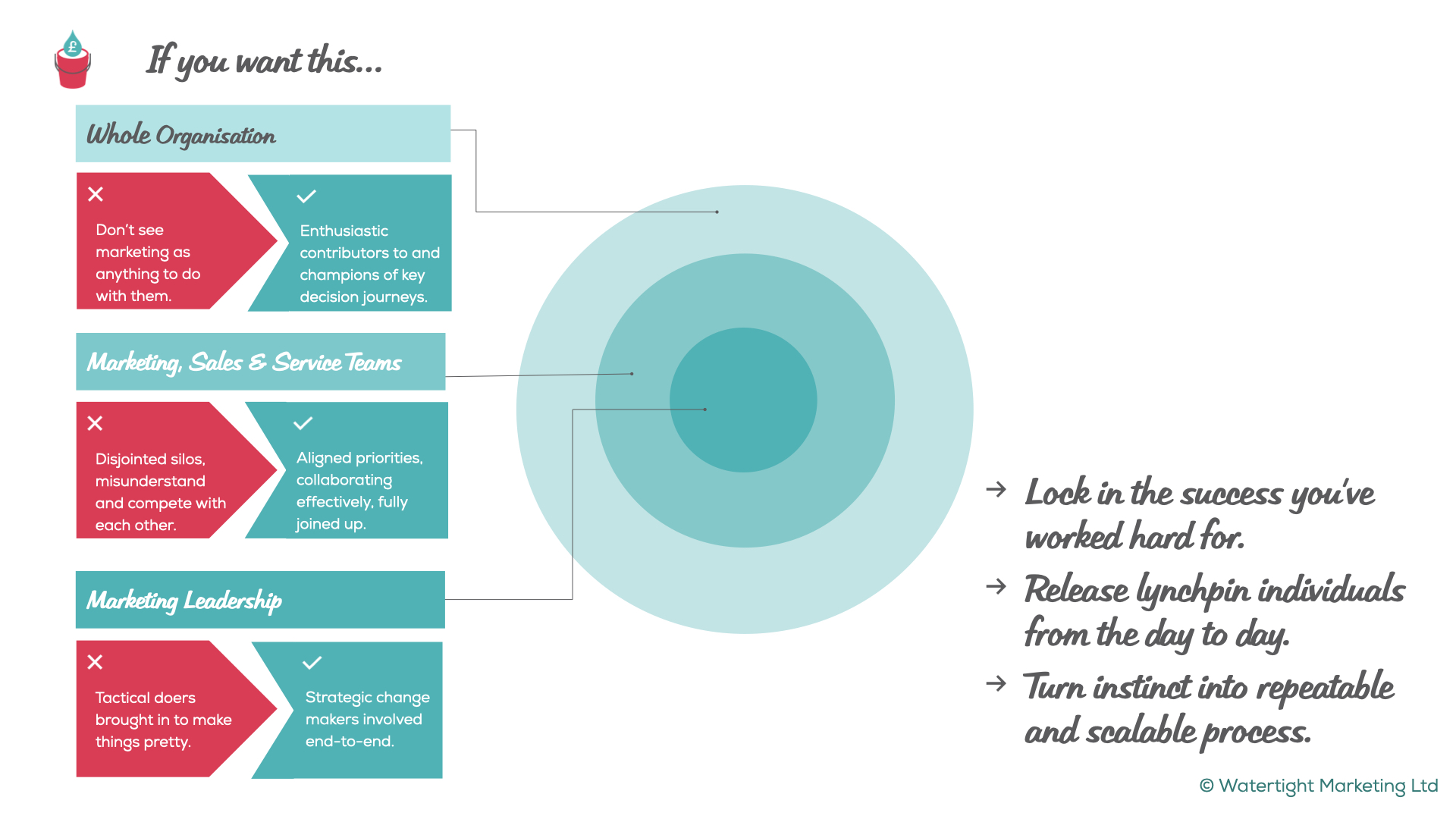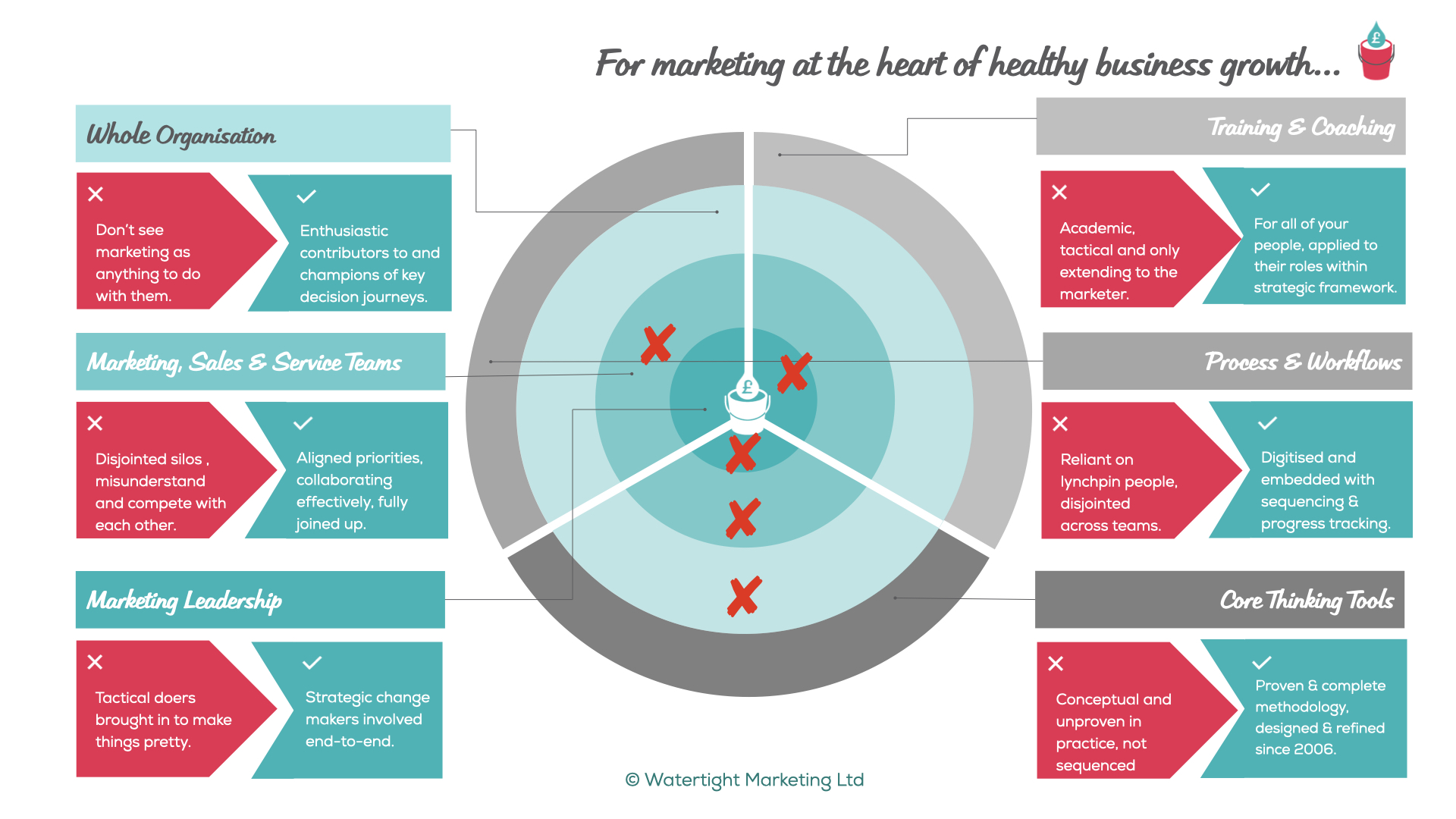Reading Time: 10 Minutes
Effective marketing is as much a matter of organisational context as it is individual competence. For marketing to work, two key ingredients are: good marketers and a well-organised, productive marketing team. However, for the whole business to gain the most value from marketing, you want everyone to play their part to ‘get’ marketing. It’s an organisational marketing capability that really shows you have a customer-centric organisation. ~ Rachael Wheatley, Managing Director | Watertight Thinking
Listen to the session podcast here
52-minute roundtable discussion on creating an organisational marketing capability
When we talk about marketing capability we talk about it at three levels. There’s the individual, the most senior marketer. There’s the team whose day job is to deliver on a marketing strategy and plan. And then there’s everyone else. It’s those outside the marketing team whose contribution is often missed as a key element of making marketing truly deliver value.
Is marketing in your business seen as a peripheral activity, a blip on the outside of the organisation? Or is it at it’s heart, driving decisions and thinking, supporting the business plan?
What we explored in our roundtable this month was how things might not work and how things do work when you have that full organisational capability.
What you see when it doesn’t work….and when it does
When it doesn’t work at an organisational level, marketing is not seen as anything to do with the senior leaders or teams in the wider business. It’s something they come to last. Think, those Board meetings where “Marketing” is last on the agenda and it’s touch-and-go whether there’s time for it!
At the marketing, sales and service team level, you’d see silo-working, teams which misunderstand each other and even which compete rather working hand in glove. You’ll see a tussle between whose responsibility is the customer journey, who designs the customer proposition, who leads on client relationships.
And finally, there’s the marketing leadership level. When things don’t work at this level, they’re seen as tactical doers, brought in to make things look pretty.
When it does work, you’ll see:
- Enthusiastic contributors to and champions of key decision journeys (the customers to buy, prospective employees to work with you, suppliers to want to work for you).
- Aligned priorities in the marketing, sales and service teams, collaborating effectively and fully joined up.
- Marketing leaders seen as strategic change makers involved end to end in the business.

If you want this, you need tools and a common language, to set the right context and to create alignment across the whole organisation.
A common language, the right context and alignment
So how can you achieve these things and move towards a marketing capability that works at those three levels – marketing leadership, teams and the whole organisation? The answers are:
Training and coaching: for everyone, applied to their roles (and not for the marketers only, not theoretical and not purely tactical).
Process and workflows: digitised, embedded, sequenced and with progress tracked (not reliant on lynchpin individuals who may not always be around).
Core thinking tools: a proven, comprehensive methodology embedded across the organisation using tools that can be applied to your business.
People try to fix marketing and can make mistakes
Train the marketer – just the marketer – is a common fix. They do a good course and then come back to the business having to try and train others on what they’ve learned. Often, these courses use case studies and tools that are theoretical and not related to your business and it can be hard to squeeze what you’ve learned into a different-shaped hole that simply won’t fit with real life. I remember first learning about Boston Consulting Group’s matrix in my mid 20’s, excited to see how it worked in practice, only to find it impossible to apply: the data wasn’t there and there were no definitions for the different quadrants.
The other mistake here is where marketers are trained in a specific tactical area. As useful as that is, it’s only one bit of the jigsaw.
Another ‘fix’ is the use of theories, tools or methodologies – understood only by the people who’ve learned it (the marketer who’s using Ansoff’s matrix or the sales team who are implementing SPIN or the business who have invested in EOS, the Entrepreneurial Operating System).
The final ‘fix’ we mentioned was the technical solution – implement Hubspot, Salesforce or some other CRM system. It’s useful, yes. But it only addresses one element of marketing capability.

The fixes are usually focused in one of these three areas (training, process & workflows, core thinking tools) at one of the three levels (individual, team or organisation).
What works best – and what we do with clients – it to make sure we’re not fixing marketing piecemeal but creating the whole. It’s what will create a business-wide marketing capability, and it’s the context in which marketing and marketers will truly thrive.
What characterises a business with marketing on the periphery or marketing at the heart?
Rachael Wheatley: I thought it would be helpful to characterise two organisations I worked where one definitely had a business-wide marketing capability, and the other didn’t. The first job I had was for an academic publishing company where I joined a sales and marketing department, led by a very marketing savvy salesperson. The editors sought sign off on any new book and we worked closely with customer services. It felt integrated. The next business I worked for was a law firm. That’s where I felt like marketing was a pimple on the outside of the firm. They were very new to marketing since marketing in legal services had only recently opened up, so were quite immature marketing-wise. They saw marketing in a very pigeon-holed way – PR and events, essentially at that time. So two very different businesses at opposite ends of the marketing capability and maturity spectrum. In one I thrived, in the other it was more of a struggle.
Bryony Thomas: We’re talking about the in-house marketing team, not a marketing agency. In lots of businesses, they see their marketing department as an agency: right, we’ve come up with the product, can you just make it pretty now? Or, we know what our sales points are, can you now generate some leads (which is an end-of-process activity that you’d often brief to an agency).
Cheryl Crichton: Another thing I’ve seen is, depending on the background of the senior management team, or indeed the MD, or the owners of the business, past experiences can influence how they recruit. So if you have someone who’s all about sales, then he’ll probably recruit a sales team above a marketing team. The decision to recruit and build teams is based on what the MD or senior management team knows.
Bryony Thomas: you made a really interesting point in the chat, Cheryl, about marketing sometimes landing in IT because of what people assume about marketing – it’s digital, so it must be IT. But placing it there trains people to press buttons rather than as strategic thinkers. It’s a solution, but again, it’s only addressing the technical fix.
James Massey: I’ve just joined a company which has never really done marketing and the MD is saying: the marketing strategy can wait, let’s get on with other bits of the plan, so marketing is seen as an add-on.
Bryony Thomas: If you get your MD and others in the team to do our test and then sit down together to discuss it, I think that will get you a long way, and help change to change that conversation.
People’s past experience of marketing influences how they see it now and how they interact with their marketing colleagues
Su Copeland: I recognise absolutely everything you’ve described, that is siloing of marketing activity and seeing it as a tactical function of the business rather than part of the strategic leadership. I go straight to the senior team first, the CEO or MD and whoever they think should be included in the conversation at that senior level and define sales and marketing in very simple terms and then say, “What are you trying to achieve?” I don’t care whether they call it marketing, business development, whatever. I’ll work with whoever they bring it.
Bryony Thomas: Yes, I don’t really care whether people call it sales, marketing, business development, account management, revenue generation, customer journey, customer experience client success – just do it properly! That’s why Watertight is so powerful – it’s that common language. I’ll say marketing and I will be thinking strategy; the IT team will be thinking someone who updates the website. The word marketing can mean so many different things to different people and so you have to define it.
Sometimes, I’ve found that if you have a sales or a BD team that have never worked with an effective marketing team, they just think you’re trying to muscle in on their space. Whereas if you work with salespeople who have had really successful relationships with marketers before, they say, “Oh, we’re reviewing the proposition, let’s do that together.” It’s fascinating, that what they bring to the role changes the way that you interact.
Su Copeland: Marketing is everyone’s role, everyone needs to be on message. That means you need to bring people on side, starting with the MD and senior team, helping them to understand how marketing can help.
Dan Bond: I’ve worked for l lots of different companies, different sizes, mainly B2B. It’s a lot easier when the company is smaller, and you have more access to the leadership. In a big company, there’s tons of people doing very small pieces of the whole picture, so it’s hard to penetrate something that big. It also helps if the person who hires you understands marketing.
Bryony Thomas: I’d go further. When you’re going for a marketing job, I think finding that out of your leadership, seeing what’s there currently, what’s their previous experience of marketers, what’s their perception of marketing. You might be the best marketer in the world, but depending on the context, you may or may not be able to perform in role. Better if you’ve got someone there that you can talk to, and you’ve worked with before. You know what you’re getting into. Those of you who are recruiting marketers, letting them know how you perceive marketing is critical.
Rachael Wheatley: You have to be up for the challenge, if marketing is not perceived as you would like it to be. And often you need an ally or champion at a senior level. Otherwise you are not going to thrive, it’ll be too difficult.
Bryony Thomas: Last year we helped recruit a new marketing director into her role. But we’d worked with their leadership team for a year before that. So it was only really at that point that they were ready. Prior to that they thought they were going to recruit a doer. It took them a little while to understand that actually what they needed was a thinker. By the time they recruited, everybody around the leadership table knew what the interface was going to be when that person came into role, and that was critical to her succeeding.
Peter Baynes: People I’ve worked well with are often in sales and it’s them that’s championed marketing. What we have in common is an understanding of people and customers, their behaviour. I’m working with a company now who have just brought in a customer success manager who doesn’t get marketing, so there’s some work to do there to align what they’re doing with sales and marketing and to help them see that we’re all working together.
How to help people to see where their role in marketing is
Andrew Beeput: As a CEO of a small charity, understanding that everybody’s role is connected to our marketing piece is important. So, whoever picks up a phone, responds to an email – marketing is everybody’s role. We’ve previously done a big piece of work with Watertight looking at various different leaks. It has changed how we do marketing; in fact, I no longer call it marketing, it carries so much baggage. When I started talking about how we need to enhance our thinking around marketing and how we build it into everyday tasks, I can see people’s eyes roll when I mentioned the word!
At the moment, as a business, we’re thinking, do we need marketing thinker, do we need somebody to do sales? Actually, I need somebody who does sales but who also understands marketing. Getting the right character is part of my challenge. Do I need two separate people? But I could create a real tension between these two people if I don’t get the salesperson right.
Bryony Thomas: I’d point people to the Touchpoint Leaks framework. If you go through that with your team, you can get everybody to put a post-it note against their role. What we’ve defined in the book is the marketing tools, that can be used to tweak each leak, but there are also skills, roles and responsibilities. So you could ask: what do you do in your day to day job that supports this bit or that bit and what you end up with is an understanding of the roles and responsibilities, the behaviours and attitudes, and where the handoffs and overlaps are. What you want is someone in account management saying they’ve had a great call with a customer that would make an amazing case study, asking the customer if marketing can speak them and handing them over to their colleague to create the case study.
Su Copeland: Employing a marketing-savvy sales person is difficult – they’re a rare breed. Don’t go for 100% of what you need, because they probably don’t exist. 80% is probably good enough. And, you might find that what you need is, for example, a full time salesperson and a part time marketing, strategic thinker. You can’t fix a hole with one person.
Bryony Thomas: Exactly so. In the same way as you can’t fix a ‘marketing capability’ hole with one thing. To get to that organisational capability, it needs to be a combination of tools, training, technology, people, skills, process.
Watertight Wisdom
What’s worked for us
Ideas from the group about how to use metrics:
- Effective marketing is as much a matter of organisational context as it is individual competence. Having good marketers is not enough; for marketing to be truly effective the wider business needs to have a common understanding of ‘marketing’.
- Enthusiastic contributors and champions of key decision journeys are signs of a mature, marketing-capable organisation.
- Aligned priorities in sales, marketing and service is a sign that marketing works at a teams level.
- Marketing leaders seen as strategic change makers involved end to end in the business is a sign marketing is working in the whole business.
- Training & coaching, process & workflows and core thinking tools. These combined are the things that help you achieve business-wide marketing capability.
- Don’t stop with training only the marketer. They’ll find it hard to adapt, apply and implement anything they’ve leaned unless others in the business are part of that learning.
- If marketing doesn’t work and you try and fix it make sure you fix it at each of the three levels: organisation, teams and individual.
- Where marketing is peripheral in a business it won’t work, it won’t add value or have the impact you want it to.
- MD’s past experience of marketing affects how they perceive it now. If it’s been a positive experience, it makes it much easier for marketing to thrive.
- Help people to see where their role is in marketing. Using a provide framework like the Touchpoint Leaks® makes it easy for people to see where their responsibilities are and where the overlaps and handoffs are.
What would you add to our list? Do let us know your thoughts.
To join the conversation at our next Watertight Wednesday marketing roundtable you can sign up here. Next time we will be talking about Creating an organisational marketing capability.

Subscribe to the CMO Toolkit
Would you like to get your hands on the tools, frameworks, templates, workshop packs, slides, and analysis tools we use with our clients? It’s all waiting for you.

Rachael Wheatley
Managing Director, Watertight Thinking
Rachael brings over 30 years’ of marketing experience, with a particular focus on building and developing effective marketing teams that are able to act as a strategic driving force across an organisation. She has worked with Watertight since 2014 as a Master Practitioner and joined the business as MD in 2022.



